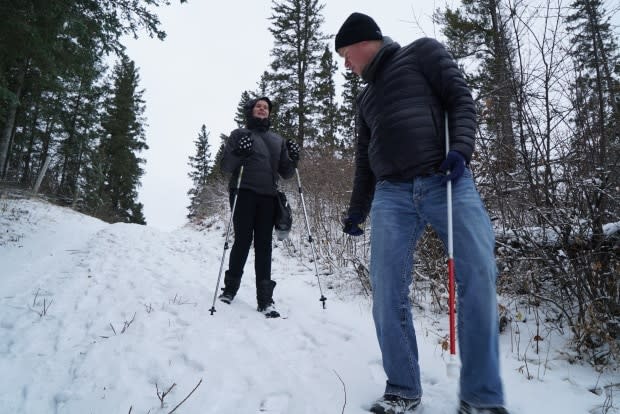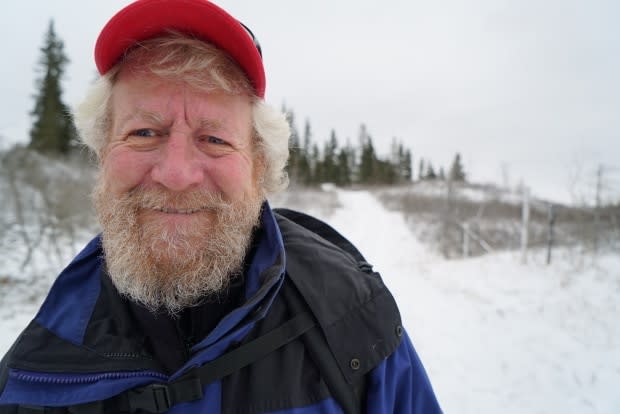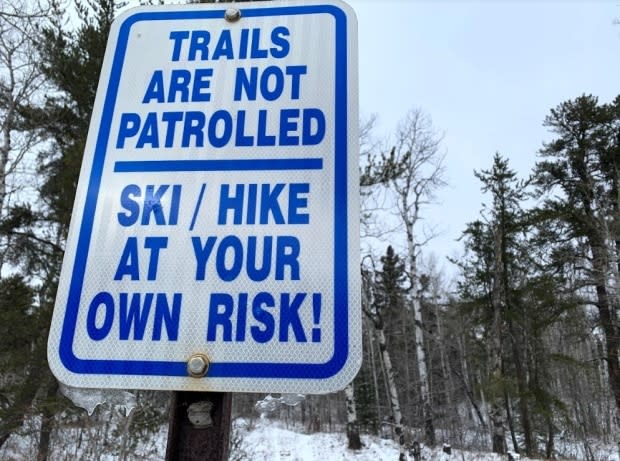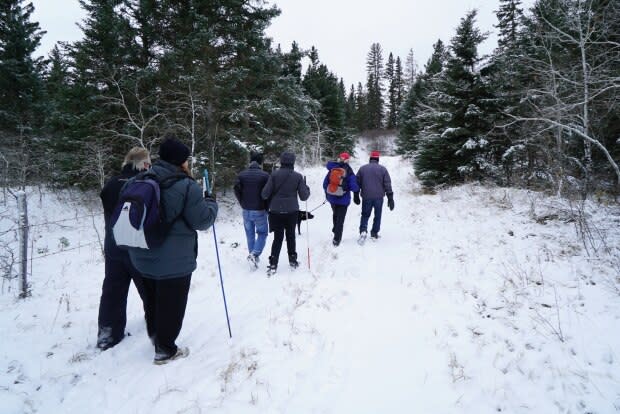Blind Sask. man pairing sighted and visually impaired people for outdoor adventures

"You're doing good," says Tyler Mathieson as he walks just a few paces ahead of Charlene Young.
It's late October, the day after the first major snowfall in this part of Saskatchewan. The pair is hiking a wooded trail about 100 kilometres northeast of Saskatoon.
As they walk, Mathieson is keeping up a constant dialogue with Young, their back-and-forth punctuated by the crunch of snow under their boots and the clinking of Young's ski poles against rock.
Young is blind. Mathieson is not. They're one of three pairs out on Eb's Trail this Sunday afternoon at the suggestion of Ron Walsh, a Saskatoon man eager to prove that people with visual impairments can do more than they perhaps realize.
"Stick to the right because it slopes to the left," Mathieson says of the trail. "You're doing good."
Listen to how Mathieson guided Young along the trail:
"You don't want to be too specific," Mathieson says later of his instructions to Young, "because by the time you describe something, they're past it."

Walsh, 60, is living proof that visual impairment should not impair your sense of adventure.
'A beautiful thing to watch'
Walsh was not born blind. His sight diminished gradually. He first noticed something was up while hunting deer with his friends. He was 27.
"They could see a deer; I couldn't," says Walsh. So, he got glasses.
Five years later, in a construction shop, he couldn't see a saw that was right behind him on a shelf.
"Right there I knew it was something more than just glasses."
Walsh is totally blind now. When he closes his eyes, "It's like little flecks of light here and there. Nothing that I can use."

But Walsh says he's actually been more active since his vision began dimming. Unable to drive, he started biking to work, even pedalling from Calgary to Victoria once for fun. That eventually got too risky, so now he cross-country skis and hikes.
Walsh and Mathieson bonded at the gym. Mathieson got in for free for assisting Walsh. Then, their adventures began.
In 2017, Mathieson guided Walsh along the 53-kilometre Chilkoot Trail in Alaska and British Columbia.
You feel concerned for them. But at the same time you know these people have gone through a lifetime of handling themselves and they just need a little bit of guidance. - Tyler Mathieson, Blind Adventure guide
"I told Ron for quite a while I wasn't gonna go with him," Mathieson says. "I wasn't confident that he would be able to do it safely or that I'd be able to get him through it safely."
Mathieson took Walsh near Saskatoon's Circle Drive South Bridge, to see if he could navigate over the cobbles and boulders.
"We started walking over these rocks and I could not believe how well he was able to take it on," Mathieson says.
"He's pretty much Rubbermaid."
Their system is simple: Mathieson walks ahead holding a walking pole. Walsh follows, grasping the other end of the pole. (They first tried tent poles at someone's suggestion. It didn't go well.)
"Since the pole is stiff I can direct him left or right and I can pull forward or communicate to him to stop," as Mathieson demonstrated on the Eb's Trail hike.
"He's just, through attrition, taking over the environment. It's a beautiful thing to watch."
It's scary, too.
"You feel concerned for them," Mathieson says. "But at the same time you know these people have gone through a lifetime of handling themselves and they just need a little bit of guidance."

Getting guides and blind people to get over that initial barrier of concern or self-doubt is what Walsh is all about.
He's launched an initiative called Blind Adventurer. The goal is to organize hikes and other activities where sighted people pair up with blind people to give them a chance to get out and get their heart rates going.
"I noticed that in certain clubs I am the only blind person involved," Walsh says. "Physical fitness is a very important part of your life. A lot of people who are blind, they don't have that.
"I know people who basically sat there and read a book during Phys. Ed."

'I would have never experienced that'
Also joining Walsh at Eb's Trial was Monique Lalonde. She walked arm in arm with Walsh's younger brother, Richard.
Lalonde has been blind from birth, but she grew up on a farm, where she did not get special treatment.
"If mom and dad decided that we were going for a walk, we were all going for a walk," she says.
Once Lalonde was on her own at university, she had to nag herself to maintain an active lifestyle.
"It was so much simpler to isolate myself or to find people who didn't really care about being active — blind or sighted," Lalonde says. "I had some sighted friends [for whom] it was more fun to play video games and sit in front of a TV."

Blind Adventurer is not just about fitness. Walsh says it's also about gaining life experiences taking blind people outside their comfort zones.
Case in point: the guided hike through Prince Albert National Park's Grey Owl Trail that Walsh and Lalonde joined last August.
One night, the group went to bed early after dinner.
"Monique and myself were in one tent," Walsh says. "The two guides were in the other tent. They heard bears all night. There were bears using their noses, rubbing up against the tent, even brushing their body up against the tent. I didn't hear any bear bangers, so I slept through the whole thing.
"That's something I'll remember for the rest of my life. And if I was at home, I would have never experienced that."


